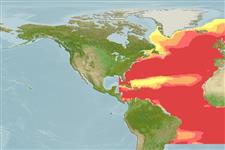Environment: milieu / climate zone / depth range / distribution range
Ecología
marino batipelágico; rango de profundidad 100 - 1800 m (Ref. 87004), usually 100 - 1100 m (Ref. 87004). Subtropical; 75°N - 25°S, 85°W - 0°W
Distribución
Países | Áreas FAO | Ecosistemas | Ocurrencias, apariciones | Point map | Introducciones | Faunafri
Atlantic Ocean: From Iceland to Brazil and Guinea Gulf, from Caribbean to West Africa.
Tamaño / Peso / Age
Maturity: Lm ? range ? - ? cm
Max length : 11.0 cm SL macho / no sexado; (Ref. 123983)
Short description
Morfología | Morfometría
Espinas dorsales (total): 7 - 8; Radios blandos dorsales (total): 10-11; Espinas anales 3; Radios blandos anales: 7 - 8; Vértebra: 24 - 26. 3 scale rows under the D2 origin down to the lateral line, 10-11 (rarely 12-13) in total. 14-15 pelvic fin rays, rarely 16.
Individuals 7.5 cm SL and longer mostly occur in the boreal areas, while those less than this the length occur in the tropical areas (Ref. 87004). Maximum length reported in Ref. 87004: 11 cm TL.
Life cycle and mating behavior
Madurez | Reproducción | Puesta | Huevos | Fecundidad | Larva
Santos, R.S., F.M. Porteiro and J.P. Barreiros, 1997. Marine fishes of the Azores: annotated checklist and bibliography. Bulletin of the University of Azores. Supplement 1. 244 p. (Ref. 35204)
IUCN Red List Status (Ref. 130435)
Threat to humans
Harmless
Human uses
Pesquerías:
Más información
PaísesÁreas FAOEcosistemasOcurrencias, aparicionesIntroduccionesStocksEcologíaDietacomponentes alimenticiosconsumo de alimentoRación
Nombres comunesSinónimosMetabolismoDespredadoresEcotoxicologíaReproducciónMadurezPuestaAgregación para la puestaFecundidadHuevosEgg development
Age/SizeCrecimientoLength-weightLength-lengthLength-frequenciesMorfometríaMorfologíaLarvaDinámica larvariaReclutamientoAbundanciaBRUVS
ReferenciasAcuiculturaPerfil de acuiculturaRazasGenéticaElectrophoresesheritabilidadEnfermedadesProcesamientoNutrientsMass conversion
ColaboradoresImágenesStamps, Coins Misc.SonidosCiguateraVelocidadTipo de nataciónSuperficie branquialOtolitosCerebrosVisión
Herramientas
Special reports
Download XML
Fuentes de Internet
Estimates based on models
Preferred temperature (Ref.
123201): 1.7 - 18.6, mean 7.7 °C (based on 1396 cells).
Phylogenetic diversity index (Ref.
82804): PD
50 = 0.5176 [Uniqueness, from 0.5 = low to 2.0 = high].
Bayesian length-weight: a=0.01000 (0.00244 - 0.04107), b=3.04 (2.81 - 3.27), in cm total length, based on all LWR estimates for this body shape (Ref.
93245).
Nivel trófico (Ref.
69278): 3.4 ±0.5 se; based on size and trophs of closest relatives
Resiliencia (Ref.
120179): Medio, población duplicada en un tiempo mínimo de 1.4-4.4 años (Fecundity assumed < 1000).
Fishing Vulnerability (Ref.
59153): Low vulnerability (10 of 100).
